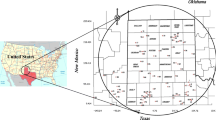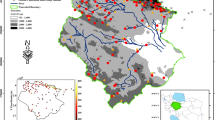Abstract
The inverse distance method, one of the commonly used methods for analyzing spatial variation of rainfall, is flexible if the order of distances in the method is adjustable. By applying the genetic algorithm (GA), the optimal order of distances can be found to minimize the difference between estimated and measured precipitation data. A case study of the Feitsui reservoir watershed in Taiwan is described in the present paper. The results show that the variability of the order of distances is small when the topography of rainfall stations is uniform. Moreover, when rainfall characteristic is uniform, the horizontal distance between rainfall stations and interpolated locations is the major factor influencing the order of distances. The results also verify that the variable-order inverse distance method is more suitable than the arithmetic average method and the Thiessen Polygons method in describing the spatial variation of rainfall. The efficiency and reliability of hydrologic modeling and hence of general water resource management can be significantly improved by more accurate rainfall data interpolated by the variable-order inverse distance method.
Similar content being viewed by others
References
Bartier, P. M. and Keller, C. P.: 1996, ‘Multivariate interpolation to incorporate thematic surface data using inverse distance weighting (IDW)’, Comput. Geosci. 22(7), 795–799.
Chaubey, I., Haan, C. T., Grunwald, S. and Salisbury, J. M.: 1999, ‘Uncertainty in the model parameters due to spatial variability of rainfall’, J. Hydrol. 220, 48–61.
Cheng, C. T., Ou, C. P. and Chau, K. W.: 2002, ‘Combining a fuzzy optimal model with a genetic algorithm to solve multi-objective rainfall-runoff model calibration’, J. Hydrol. 268, 72–86.
Dirks, K. N., Hay, J. E., Stow, C. D. and Harris, D.: 1998, ‘High-resolution studies of rainfall on Norfolk island, Part IO: The spatial variability of rainfall’, J. Hydrol. 208, 163–186.
Dirks, K. N., Hay, J. E., Stow, C. D. and Harris, D.: 1998, ‘High-resolution studies of rainfall on Norfolk island, Part II: Interpolation of rainfall data’, J. Hydrol. 208, 187–193.
Donald, L. Ph. and Danny, G. M.: 1996, ‘Spatial uncertainty analysis: Propagation of interpolation errors in spatially distributed models’, Ecol. Model. 91, 213–229.
Faures, J. M., Goodrich, D. C., Davis, A. W. and Soroosh, S.: 1995, ‘Impact of small-scale spatial variability on runoff modeling’, J. Hydrol. 173, 309–326.
Goldberd, D. E.: 1989, Genetic Algorithm in Search, Optimization and Machine Learning, Addison-Wesley, MA.
Nalder, I. A. and Wein, R. W.: 1998, ‘Spatial interpolation of climatic normals: Test of a new method in the Canadian boreal forest’, Agric. For. Meteorol. 92, 211–225.
Tabios, G. O. and Salas, J. D.: 1985, ‘A comparative analysis of techniques for spatial interpolation of precipitation’, Water Resour. Res. 21, 365–380.
Todini, E. and Ferraresi, M.: 1996, ‘Influence of parameter estimation uncertainty in Kriging’, J. Hydrol. 175, 555–566.
Troutman, B. M.: 1983, ‘Runoff prediction errors and bias in parameter estimation induced by spatial variability of precipitation’, Water Resour. Res. 19(3), 791–810.
Vicente, L. L.: 1996, ‘On the effect of uncertainty in spatial distribution of rainfall on catchment modeling’, Catena 28, 107–119.
Wang, Q. J.: 1991, ‘The genetic algorithm and its application to calibrating conceptual rainfall-runoff models’, Water Resour. Res. 27(9), 2467–2471.
Author information
Authors and Affiliations
Corresponding author
Rights and permissions
About this article
Cite this article
Chang, CL., Lo, SL. & Yu, SL. The Parameter Optimization in the Inverse Distance Method by Genetic Algorithm for Estimating Precipitation. Environ Monit Assess 117, 145–155 (2006). https://doi.org/10.1007/s10661-006-8498-0
Received:
Accepted:
Issue Date:
DOI: https://doi.org/10.1007/s10661-006-8498-0




